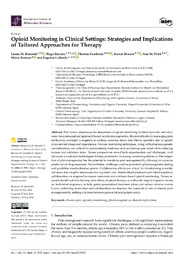Please use this identifier to cite or link to this item:
https://hdl.handle.net/11000/32545Full metadata record
| DC Field | Value | Language |
|---|---|---|
| dc.contributor.author | Rosendo, Luana M. | - |
| dc.contributor.author | Rosado, Tiago | - |
| dc.contributor.author | Zandonai, Thomas | - |
| dc.contributor.author | Rincon, Karem | - |
| dc.contributor.author | Peiró, Ana | - |
| dc.contributor.author | Barroso, Mário | - |
| dc.contributor.author | Gallardo, Eugenia | - |
| dc.contributor.other | Departamentos de la UMH::Farmacología, Pediatría y Química Orgánica | es_ES |
| dc.date.accessioned | 2024-07-18T10:32:51Z | - |
| dc.date.available | 2024-07-18T10:32:51Z | - |
| dc.date.created | 2024-05-29 | - |
| dc.identifier.citation | International Journal of Molecular Sciences 2024, nº 25, 5925. | es_ES |
| dc.identifier.issn | 1422-0067 | - |
| dc.identifier.uri | https://hdl.handle.net/11000/32545 | - |
| dc.description.abstract | This review emphasises the importance of opioid monitoring in clinical practice and advocates for a personalised approach based on pharmacogenetics. Beyond effectively managing pain, meticulous oversight is required to address concerns about side effects, specially due to opioidcrisis- related abuse and dependence. Various monitoring techniques, along with pharmacogenetic considerations, are critical for personalising treatment and optimising pain relief while reducing misuse and addiction risks. Future perspectives reveal both opportunities and challenges, with advances in analytical technologies holding promise for increasing monitoring efficiency. The integration of pharmacogenetics has the potential to transform pain management by allowing for a precise prediction of drug responses. Nevertheless, challenges such as prominent pharmacogenetic testing and guideline standardisation persist. Collaborative efforts are critical for transforming scientific advances into tangible improvements in patient care. Standardised protocols and interdisciplinary collaboration are required to ensure consistent and evidence-based opioid monitoring. Future research should look into the long-term effects of opioid therapy, as well as the impact of genetic factors on individual responses, to help guide personalised treatment plans and reduce adverse events. Lastly, embracing innovation and collaboration can improve the standard of care in chronic pain management by striking a balance between pain relief and patient safety | es_ES |
| dc.format | application/pdf | es_ES |
| dc.format.extent | 32 | es_ES |
| dc.language.iso | eng | es_ES |
| dc.publisher | MDPI | es_ES |
| dc.rights | info:eu-repo/semantics/openAccess | es_ES |
| dc.rights.uri | http://creativecommons.org/licenses/by-nc-nd/4.0/ | * |
| dc.subject | chronic pain | es_ES |
| dc.subject | opioids | es_ES |
| dc.subject | monitoring | es_ES |
| dc.subject | pharmacogenetics | es_ES |
| dc.subject | clinical implications | es_ES |
| dc.subject.other | CDU::6 - Ciencias aplicadas::61 - Medicina::615 - Farmacología. Terapéutica. Toxicología. Radiología | es_ES |
| dc.title | Opioid Monitoring in Clinical Settings: Strategies and Implications of Tailored Approaches for Therapy | es_ES |
| dc.type | info:eu-repo/semantics/article | es_ES |
| dc.relation.publisherversion | https://doi.org/10.3390/ijms25115925 | es_ES |

View/Open:
Opioid Monitoring in Clinical Settings Strategies and Implications.pdf
380,37 kB
Adobe PDF
Share:
.png)
